CHEVROLET Express 2010 User Manual

2010 Chevrolet Express Owner Manual M
In Brief ........................................................... |
1-1 |
Instrument Panel ........................................ |
1-2 |
Initial Drive Information ............................... |
1-4 |
Vehicle Features ...................................... |
1-14 |
Performance and Maintenance ................... |
1-16 |
Seats and Restraint System ............................. |
2-1 |
Head Restraints ......................................... |
2-2 |
Front Seats ............................................... |
2-2 |
Rear Seats ............................................... |
2-6 |
Safety Belts ............................................. |
2-10 |
Child Restraints ....................................... |
2-30 |
Airbag System ......................................... |
2-60 |
Restraint System Check ............................ |
2-80 |
Features and Controls ..................................... |
3-1 |
Keys ........................................................ |
3-3 |
Doors and Locks ....................................... |
3-9 |
Windows ................................................. |
3-16 |
Theft-Deterrent Systems ............................ |
3-19 |
Starting and Operating Your Vehicle ........... |
3-22 |
Mirrors .................................................... |
3-42 |
Storage Areas ......................................... |
3-44 |
Instrument Panel ............................................. |
4-1 |
Instrument Panel Overview .......................... |
4-3 |
Climate Controls ...................................... |
4-15 |
Warning Lights, Gages, and Indicators ........ |
4-20 |
Driver Information Center (DIC) .................. |
4-36 |
Audio System(s) ....................................... |
4-59 |
Driving Your Vehicle ....................................... |
5-1 |
Your Driving, the Road, and the Vehicle ....... |
5-2 |
Towing ................................................... |
5-26 |
Service and Appearance Care .......................... |
6-1 |
Service ..................................................... |
6-3 |
Fuel ......................................................... |
6-5 |
Checking Things Under the Hood ............... |
6-12 |
All-Wheel Drive ........................................ |
6-49 |
Rear Axle ............................................... |
6-50 |
Front Axle ............................................... |
6-50 |
Noise Control System ............................... |
6-51 |
Bulb Replacement .................................... |
6-53 |
Windshield Wiper Blade Replacement ......... |
6-59 |
Tires ...................................................... |
6-60 |

Appearance Care ................................... |
6-102 |
Vehicle Identification ............................... |
6-109 |
Electrical System .................................... |
6-109 |
Capacities and Specifications ................... |
6-116 |
Maintenance Schedule ..................................... |
7-1 |
Maintenance Schedule ................................ |
7-2 |
Customer Assistance Information .................... |
8-1 |
Customer Assistance and Information ........... |
8-2 |
Reporting Safety Defects ........................... |
8-16 |
Vehicle Data Recording and Privacy ........... |
8-18 |
Index ................................................................ |
1 |
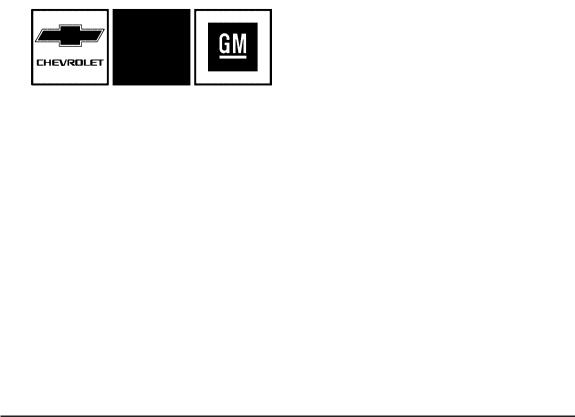
GENERAL MOTORS, GM, the GM Emblem, CHEVROLET, the CHEVROLET Emblem, and the name EXPRESS are registered trademarks of General Motors Corporation.
This manual describes features that may or may not be on your specific vehicle either because they are options that you did not purchase or due to changes subsequent to the printing of this owner manual. Please refer to the purchase documentation relating to your specific vehicle to confirm each of the features found on your vehicle. For vehicles first sold in Canada, substitute the name “General Motors of Canada Limited” for Chevrolet Motor Division wherever it appears in this manual.
If the vehicle has the DURAMAX® Diesel engine, refer to the DURAMAX® Diesel supplement for additional and specific information on this engine.
Keep this manual in the vehicle for quick reference.
Litho in U.S.A.
Part No. 25830408 A First Printing
Canadian Owners
Propriétaires Canadiens
A French language copy of this manual can be obtained from your dealer/retailer or from:
On peut obtenir un exemplaire de ce guide en français auprès du concessionnaire ou à l’adresse suivante:
Helm, Incorporated
P.O. Box 07130
Detroit, MI 48207
1-800-551-4123
Numéro de poste 6438 de langue française www.helminc.com
Index
To quickly locate information about the vehicle, use the index in the back of the manual. It is an alphabetical
list of what is in the manual and the page number where it can be found.
© 2009 General Motors Corporation. All Rights Reserved.
iii

Safety Warnings and Symbols
Warning Messages found on vehicle labels and in this manual describe hazards and what to do to avoid
or reduce them.
Danger indicates a hazard with a high level of risk which will result in serious injury or death.
Warning or Caution indicates a hazard that could result in injury or death.
{ WARNING:
These mean there is something that could hurt you or other people.
Notice: This means there is something that could result in property or vehicle damage. This would not be covered by the vehicle’s warranty.
A circle with a slash through it is a safety symbol which means “Do Not,” “Do not do this,”
or “Do not let this happen.”
Vehicle Symbols
The vehicle has components and labels that use symbols instead of text. Symbols are shown along with the text describing the operation or information relating to a specific component, control, message, gage, or indicator.
M : This symbol is shown when you need to see your owner manual for additional instructions or information.
* : This symbol is shown when you need to see a service manual for additional instructions or information.
iv

Vehicle Symbol Chart
Here are some additional symbols that may be found on the vehicle and what they mean. For more information on the symbol, refer to the index.
9 : Airbag Readiness Light
# : Air Conditioning
! : Antilock Brake System (ABS)
g : Audio Steering Wheel Controls or OnStar®
$ : Brake System Warning Light
" : Charging System
I : Cruise Control
B : Engine Coolant Temperature
O : Exterior Lamps
# : Fog Lamps
. : Fuel Gage
+ : Fuses
i : Headlamp High/Low-Beam Changer
j : LATCH System Child Restraints
* : Malfunction Indicator Lamp
: : Oil Pressure
} : Power
/ : Remote Vehicle Start
> : Safety Belt Reminders
7 : Tire Pressure Monitor
_ : Tow/Haul Mode
F : Traction Control
M : Windshield Washer Fluid
v

NOTES
vi

Section 1 |
In Brief |
|
|
Instrument Panel .............................................. |
1-2 |
Initial Drive Information .................................... |
1-4 |
Remote Keyless Entry (RKE) System ................ |
1-4 |
Remote Vehicle Start ...................................... |
1-4 |
Door Locks .................................................... |
1-5 |
Windows ....................................................... |
1-6 |
Seat Adjustment ............................................. |
1-6 |
Safety Belt .................................................... |
1-8 |
Airbag On-Off Switch ...................................... |
1-8 |
Sensing System for Passenger Airbag ............... |
1-9 |
Mirror Adjustment ........................................... |
1-9 |
Steering Wheel Adjustment ............................ |
1-10 |
Interior Lighting ............................................ |
1-11 |
Exterior Lighting ........................................... |
1-11 |
Windshield Wiper/Washer ............................... |
1-12 |
Climate Controls ........................................... |
1-13 |
Vehicle Features ............................................. |
1-14 |
Radio(s) ...................................................... |
1-14 |
Portable Audio Devices .................................. |
1-15 |
Steering Wheel Controls ................................ |
1-15 |
Cruise Control .............................................. |
1-16 |
Power Outlets .............................................. |
1-16 |
Performance and Maintenance ......................... |
1-16 |
StabiliTrak® .................................................. |
1-16 |
Tire Pressure Monitor .................................... |
1-17 |
Engine Oil Life System .................................. |
1-17 |
Fuel E85 (85% Ethanol) ................................ |
1-18 |
Driving for Better Fuel Economy ..................... |
1-18 |
Roadside Assistance Program ........................ |
1-18 |
1-1
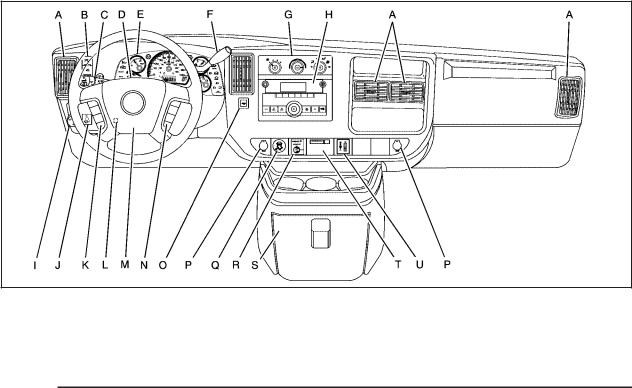
Instrument Panel
1-2

A.Outlet Adjustment on page 4-17.
B.Driver Information Center (DIC) on page 4-36.
C.Turn Signal/Multifunction Lever on page 4-4.
D.Hazard Warning Flashers on page 4-3.
E.Instrument Panel Cluster on page 4-21.
F.Shift Lever. See Starting the Engine on page 3-23.
G.Climate Control System on page 4-15.
H.Audio System(s) on page 4-59.
I.Exterior Lamps on page 4-9.
J.Instrument Panel Brightness on page 4-11.
K.Cruise Control on page 4-6. Fast Idle System
(If Equipped). See Duramax Diesel Manual for more information.
L.Tilt Wheel on page 4-3.
M.Horn on page 4-3.
N.Audio Steering Wheel Controls on page 4-77.
O.Tow/Haul Mode Button. See “Tow/Haul Mode” under
Towing a Trailer on page 5-30.
P.Accessory Power Outlet(s) on page 4-14.
Q.StabiliTrak® System on page 5-5 (If Equipped).
R.Airbag Off Switch on page 2-70.
S.Storage Areas on page 3-44.
T.Passenger Airbag Status Indicator on page 4-25.
U.Rear Heating System on page 4-18 (If Equipped).
1-3

Initial Drive Information
This section provides a brief overview about some of the important features that may or may not be on your specific vehicle.
For more detailed information, refer to each of the features which can be found later in this owner manual.
Remote Keyless Entry (RKE)
System
The RKE transmitter is used to remotely lock and unlock the doors from up to 20 m (65 feet) away from the vehicle.
Press K to unlock the driver door.
Press K again within five seconds to unlock all remaining doors.
Press j to unlock only the cargo doors.
Press Q to lock all doors.
Lock and unlock feedback can be personalized.
Press L and release to locate the vehicle.
Press L and hold for more than two seconds to sound the panic alarm. Press again to turn off the alarm.
See Keys on page 3-3 and Remote Keyless Entry (RKE) System Operation on page 3-4.
Remote Vehicle Start
With this feature the engine can be started from outside of the vehicle.
Starting the Vehicle
1.Aim the RKE transmitter at the vehicle.
2.Press Q .
3.Immediately after completing Step 2, press and hold / until the turn signal lamps flash.
1-4
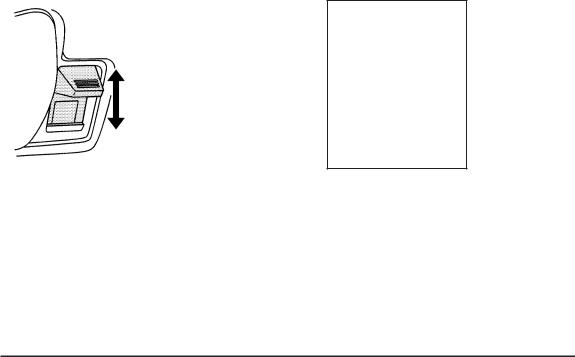
When the vehicle starts, the parking lamps will turn on and remain on as long as the engine is running. The doors will be locked and the climate control system may come on.
The engine will continue to run for 10 minutes. Repeat the steps for a 10-minute time extension. Remote start can be extended only once.
Canceling a Remote Start
To cancel a remote start:
•Aim the RKE transmitter at the vehicle and press and hold / until the parking lamps turn off.
•Turn on the hazard warning flashers.
•Turn the ignition switch ON/RUN and then back to LOCK/OFF.
See Remote Vehicle Start on page 3-7.
Door Locks
Manual Door Locks
Lock and unlock the door from the outside using the key or the RKE transmitter, if available. From the inside, slide the manual lever on the door up or down.
See Door Locks on page 3-9.
Power Door Locks
On vehicles with power door locks, the switches are located on the doors.
T : Press to lock and unlock the doors.
See Power Door Locks on page 3-10.
1-5
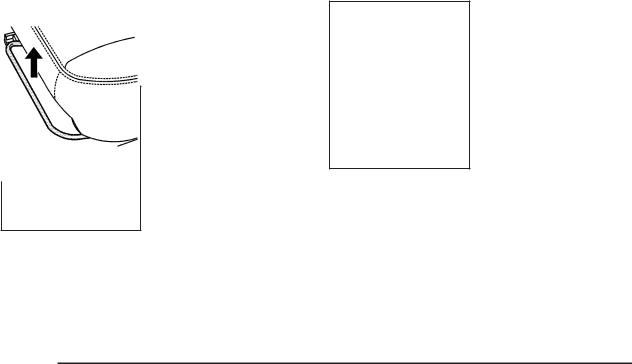
Windows
Manual Windows
Operate the manual windows by turning the hand crank on each door to raise or lower the side door windows.
See Manual Windows on page 3-16.
Power Windows
If the vehicle has power windows, the controls are located on each of the side doors. The driver door also has a control to operate the front passenger window.
Press or pull up on the switch to lower or raise the window.
See Power Windows on page 3-17.
Seat Adjustment
Manual Seats
1. Lift the bar to unlock the seat.
2. Slide the seat to the desired position and release the bar.
Try to move the seat to be sure the seat is locked in place.
See Manual Seats on page 2-2.
1-6

Power Seats |
Reclining Seatbacks |
|
|
|
|
|
|
|
If the vehicle has front power seat(s), the controls are located at the front center of the seat cushion.
Adjust the seat by moving the center knob up, down, right or left.
Raise and lower the front or rear of the seat cushion by moving the right or left lever up or down.
See Power Seat on page 2-3.
To recline the seatback:
1.Lift the recline lever on the inboard side of the seats.
2.Move the seatback to the desired position, then release the lever to lock the seatback in place.
3.Push and pull on the seatback to make sure it is locked.
See Reclining Seatbacks on page 2-4.
1-7
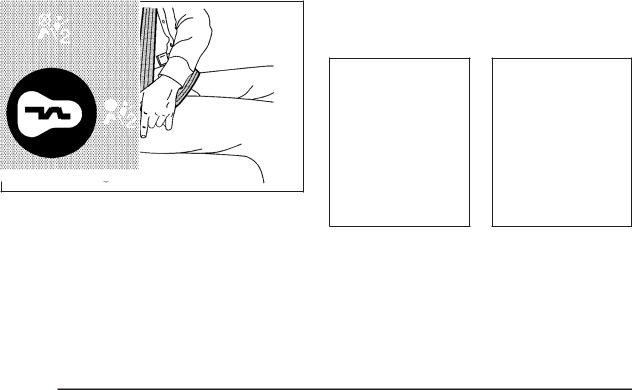
Safety Belt
Refer to the following sections for important information on how to use safety belts properly.
•Safety Belts: They Are for Everyone on page 2-10.
•How to Wear Safety Belts Properly on page 2-15.
•Lap-Shoulder Belt on page 2-23.
•Lower Anchors and Tethers for Children (LATCH) on page 2-42.
Airbag On-Off Switch
If the instrument panel has one of the switches pictured in the following illustrations, the vehicle has an airbag on-off switch that you can use to manually turn on or off the right front passenger airbag.
See Airbag Off Switch on page 2-70 for important information.
1-8

Sensing System for Passenger Airbag
The passenger sensing system, if equipped, will turn off the right front passenger frontal airbag under certain conditions. The driver airbag and roof-rail airbags,
if equipped, are not affected by this.
If the vehicle has a passenger sensing system, the passenger airbag status indicator will be visible on the instrument panel when the vehicle is started.
United States
See Passenger Sensing System on page 2-73 for important information.
Mirror Adjustment
Exterior Mirrors
Vehicles with outside manual mirrors can be adjusted by moving the mirror up and down or left to right so you can see a little of the side of your vehicle, and have
a clear view of objects behind you.
Vehicles with outside power mirrors have controls located on the driver side door.
Select each mirror by turning the knob clockwise for the passenger side mirror or counterclockwise for the driver side mirror. Adjust the mirror angle by moving the knob in the desired direction.
Keep the selector switch in the center position when not adjusting either outside mirror.
1-9

Vehicles with towing |
Steering Wheel Adjustment |
mirrors can be adjusted |
|
manually for a clear view of |
|
|
|
the objects behind you. |
|
Manually fold the mirrors inward to prevent damage when going through an automatic car wash. To fold, pull the mirror toward the vehicle. Push the mirror outward, to return it to the original position.
Interior Mirror
Hold the inside rearview mirror in the center to move it for a clearer view behind the vehicle. Adjust the
mirror to avoid glare from the headlamps behind. Push the tab, located at the base of the mirror, forward
for daytime use and pull it for nighttime use.
See Manual Rearview Mirror on page 3-42.
For vehicles with a tilt steering wheel, the lever is located on the left side of the steering column.
To adjust the steering wheel:
1.Pull the lever to move the steering wheel up or down into a comfortable position.
2.Release the lever to lock the steering wheel in place.
See Tilt Wheel on page 4-3.
1-10

Interior Lighting
Dome Lamp
The dome lamps come on when any door is opened. They turn off after all the doors are closed.
To manually turn on the dome lamps, turn the instrument panel brightness knob, located on the instrument panel to the left of the steering column, clockwise to the farthest position. In this position, the dome lamps remain on whether a door is opened or closed.
E : The dome lamp override button is located next to the exterior lamps control.
Press the button in and the dome lamps remain off when a door is opened. Press the button again to return it to the extended position so that the dome lamps come on when a door is opened.
Reading Lamps
For vehicles with reading lamps, press the button located next to each lamp to turn it on or off.
The vehicle may also have reading lamps in other locations. The lamps cannot be adjusted.
For more information on interior lighting, see:
•Instrument Panel Brightness on page 4-11.
•Entry/Exit Lighting on page 4-13.
Exterior Lighting
The exterior lamps control is located on the instrument panel to the left of the steering wheel.
O : Briefly turn the control to this position to turn the automatic headlamps and daytime running lamps (DRL) off or back on.
For vehicles first sold in Canada, the off position only works for vehicles that are shifted into the P (Park) position.
1-11

AUTO: Automatic operation of the headlamps at normal brightness and other exterior lamp.
; : Manual operation of the parking lamps and other exterior lamps, except headlamps.
2 : Manual operation of the headlamps and other exterior lamps.
For more information, see:
•Exterior Lamps on page 4-9.
•Headlamps on Reminder on page 4-10.
•Daytime Running Lamps (DRL) on page 4-10.
•Automatic Headlamp System on page 4-11.
Windshield Wiper/Washer
The lever is located on the left side of the steering column.
8 : Use for a single wiping cycle.
6 : Turn the band to adjust the delay time between wipes. Turn the band up or down for more frequent wipes or less frequent wipes.
d : Slow wipes.
a : Fast wipes.
1-12
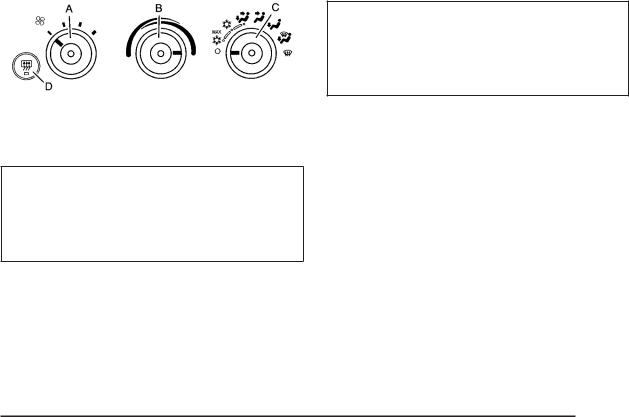
9 : Turns the wipers off.
L : Push the paddle on top of the multifunction lever to spray washer fluid on the windshield.
See Windshield Wipers on page 4-5 and Windshield Washer on page 4-6.
Climate Controls
The vehicle’s heating, cooling, and ventilation can be controlled with these systems.
A.Fan Control
B.Temperature Control
C.Air Delivery Mode Control
A. Fan Control |
C. Air Delivery Mode |
B. Temperature |
Control |
Control |
D. Rear Window |
|
Defogger |
See Climate Control System on page 4-15. See Rear Heating System on page 4-18 (If Equipped) or Rear Air Conditioning and Heating System on page 4-18
(If Equipped).
1-13

Vehicle Features
Radio(s)
Radio with CD (MP3)
O : Press to turn the system on and off. Turn to increase or decrease the volume.
BAND: Press to choose between FM and AM.
f : Select radio stations.
© ¨: Seek or scan stations.
4 : Press to display additional text information related to the current FM-RDS station or MP3 song. A choice of additional information such as: Channel, Song, Artist, and CAT (category) can display. Continue pressing to highlight the desired label, or press the softkey located under any one of the tabs and the information about that tab displays.
For more information about these and other radio features, see Audio System(s) on page 4-59.
Storing a Favorite Station
Depending on which radio the vehicle has, radio stations are stored as either favorites or presets.
For vehicles with a FAV button, a maximum of 36 stations can be stored as favorites using the
six softkeys located below the radio station frequency tabs and by using the radio FAV button. Press FAV
to go through up to six pages of favorites, each having six favorite stations available per page. Each page
of favorites can contain any combination of AM and FM stations.
If the radio does not have a FAV button, up to
18 stations (six FM1, six FM2, and six AM), can be programmed on the six numbered buttons.
See Radio(s) on page 4-62.
1-14

Setting the Clock
To set the time and date for the Radio with CD (MP3):
1.Press H and the HR, MIN, MM, DD, YYYY (hour, minute, month, day, and year) displays.
2.Press the pushbutton located below any one of the tabs that you want to change.
3.Increase or decrease the time or date depending on the radio, by pressing ©SEEK¨ arrows,
s\ REV/FWD buttons or by turning f clockwise or counterclockwise.
For detailed instructions on setting the clock for your specific audio system, see Setting the Clock on page 4-60.
Portable Audio Devices
This vehicle may have an auxiliary input jack, located on the audio faceplate. External devices such as iPod®, MP3 players, etc. can be connected to the auxiliary input jack using a 3.5 mm (1/8 in) input jack cable.
See “Using the Auxiliary Input Jack” under Radio(s) on page 4-62.
Steering Wheel Controls
If equipped, these controls are located on the right side of the steering wheel.
w / x: Press to seek radio stations or select tracks on a CD. Press and hold to scan radio stations.
g : Press to mute the audio system. Press again to cancel mute.
+ e − e : Increases or decreases volume.
SRCE: Press to choose between the radio, CD, and auxiliary input jack.
¨ : Press to seek the next radio station, or the next track or chapter while sourced to the CD.
1-15

Cruise Control
The cruise control buttons are located on the left side of the steering wheel.
J : On/Off.
RES+: Press to resume or accelerate speed.
SET−: Press to set or decrease speed.
[ : Press to cancel cruise control without erasing the set speed from memory.
For more information, see Cruise Control on page 4-6.
1-16
Power Outlets
The accessory power outlets can be used to connect auxiliary electrical equipment, such as a cellular phone.
The vehicle may have two accessory power outlets located on the instrument panel.
To use the accessory power outlet lift the cover.
See Accessory Power Outlet(s) on page 4-14 and Ashtray(s) and Cigarette Lighter on page 4-15
(If Equipped).
Performance and Maintenance
StabiliTrak®
The vehicle may have a traction control system that limits wheel spin and the StabiliTrak system that assists with directional control of the vehicle in difficult driving conditions. Both systems turn on automatically every time the vehicle is started.
•To turn off both traction control and Electronic Stability Control, press and hold d until
d illuminates and the appropriate DIC message displays. See DIC Warnings and Messages on page 4-44.
•Press and release the button again to turn on both systems.
For more information, see StabiliTrak® System on page 5-5.

Tire Pressure Monitor
This vehicle may have a Tire Pressure Monitor System (TPMS).
The Tire Pressure Monitor alerts you when a significant reduction in pressure occurs in one or more of the vehicle’s tires by illuminating the low tire pressure warning light on the instrument cluster.
The warning light will remain on until the tire pressure is corrected. The proper tire pressures for your vehicle are listed on the Tire and Loading Information label located on the driver side center pillar (B pillar). See
Loading the Vehicle on page 5-19.
You may notice during cooler conditions that the low tire pressure warning light will appear when the vehicle is first started and then turn off as you drive. This may be an early indicator that your tire pressures are getting low and the tires need to be inflated to the proper pressure.
Note: The Tire Pressure Monitor can alert you about low tire pressure, but it does not replace normal monthly tire maintenance. It is the driver’s responsibility to maintain correct tire pressures.
See Tire Pressure Monitor System on page 6-70 and Tire Pressure Monitor Operation on page 6-72.
Engine Oil Life System
The engine oil life system calculates engine oil life based on vehicle use and displays a DIC message when it is necessary to change the engine oil and filter. The oil life system should be reset to 100% only following an oil change.
Resetting the Oil Life System
1.Turn the ignition to ON/RUN, with the engine off.
2.Fully press and release the accelerator pedal three times within five seconds.
3.Turn the key to LOCK/OFF.
See Engine Oil Life System on page 6-18.
1-17

Fuel E85 (85% Ethanol)
If the vehicle has the 4.8L V8 engine (VIN Code A), the 5.3L V8 engine (VIN Code 4), or the 6.0L V8 engine (VIN Code G), and the N15 flexible fuel option you can use either unleaded gasoline or ethanol fuel containing up to 85% ethanol (E85). See Fuel on page 6-5. In
all other engines, use only the unleaded gasoline described under Gasoline Octane on page 6-6.
Vehicles that have the 4.8L V8 engine (VIN Code A), the 5.3L V8 engine (VIN Code 4), or the 6.0L V8 engine (VIN Code G) and the N15 flexible fuel option have a yellow fuel cap and can use 85% ethanol fuel (E85). See Fuel E85 (85% Ethanol) on page 6-8.
Driving for Better Fuel Economy
Driving habits can affect fuel mileage. Here are some driving tips to get the best fuel economy possible.
•Avoid fast starts and accelerate smoothly.
•Brake gradually and avoid abrupt stops.
•Avoid idling the engine for long periods of time.
•When road and weather conditions are appropriate, use cruise control, if equipped.
•Always follow posted speed limits or drive more slowly when conditions require.
•Keep vehicle tires properly inflated.
•Combine several trips into a single trip.
•Replace the vehicle’s tires with the same TPC Spec number molded into the tire’s sidewall near the size.
•Follow recommended scheduled maintenance.
Roadside Assistance Program
U.S.: 1-800-CHEV-USA (1-800-243-8872)
TTY Users: 1-888-889-2438
Canada: 1-800-268-6800
As the owner of a new Chevrolet, you are automatically enrolled in the Roadside Assistance program. This program provides technically trained advisors who are available 24 hours a day, 365 days a year, minor repair information or towing arrangements.
Online Owner Center
The Online Owner Center is a complimentary service that includes online service reminders, vehicle maintenance tips, online owner manual, special privileges and more.
Sign up today at: www.gmownercenter.com/chevrolet
(U.S.) or www.gm.ca (Canada).
1-18

Section 2 Seats and Restraint System
Head Restraints ............................................... |
2-2 |
Front Seats ...................................................... |
2-2 |
Manual Seats ................................................ |
2-2 |
Power Seat ................................................... |
2-3 |
Reclining Seatbacks ........................................ |
2-4 |
Rear Seats ....................................................... |
2-6 |
Rear Seat Operation ....................................... |
2-6 |
Safety Belts ................................................... |
2-10 |
Safety Belts: They Are for Everyone ................ |
2-10 |
How to Wear Safety Belts Properly ................. |
2-15 |
Lap-Shoulder Belt ......................................... |
2-23 |
Safety Belt Use During Pregnancy .................. |
2-29 |
Safety Belt Extender ..................................... |
2-29 |
Child Restraints ............................................. |
2-30 |
Older Children .............................................. |
2-30 |
Infants and Young Children ............................ |
2-33 |
Child Restraint Systems ................................. |
2-37 |
Where to Put the Restraint ............................. |
2-40 |
Lower Anchors and Tethers for |
|
Children (LATCH) ...................................... |
2-42 |
Securing a Child Restraint in a |
|
Rear Seat Position .................................... |
2-49 |
Securing a Child Restraint in the |
|
Right Front Seat Position |
|
(With Passenger Sensing System) ............... |
2-52 |
Securing a Child Restraint in the Right Front |
|
Seat Position (With Airbag On-Off Switch) ..... |
2-56 |
Airbag System ............................................... |
2-60 |
Where Are the Airbags? ................................ |
2-63 |
When Should an Airbag Inflate? ..................... |
2-65 |
What Makes an Airbag Inflate? ....................... |
2-67 |
How Does an Airbag Restrain? ....................... |
2-67 |
What Will You See After an Airbag Inflates? ..... |
2-68 |
Airbag Off Switch .......................................... |
2-70 |
Passenger Sensing System ............................ |
2-73 |
Servicing Your Airbag-Equipped Vehicle ........... |
2-78 |
Adding Equipment to Your |
|
Airbag-Equipped Vehicle ............................. |
2-79 |
Restraint System Check .................................. |
2-80 |
Checking the Restraint Systems ...................... |
2-80 |
Replacing Restraint System Parts |
|
After a Crash ............................................ |
2-81 |
2-1

Head Restraints
On vehicles with factory installed seats, the front seats have built-in head restraints that are not adjustable
in the outboard seating positions.
Front Seats
Manual Seats
{ WARNING:
You can lose control of the vehicle if you try to adjust a manual driver’s seat while the vehicle is moving. The sudden movement could startle and confuse you, or make you push a pedal when you do not want to. Adjust the driver’s seat only when the vehicle is not moving.
If the vehicle has a manual seat, it can be moved forward or rearward.
1. Lift the bar to unlock the seat.
2. Slide the seat to the desired position and release the bar.
Try to move the seat with your body to be sure the seat is locked in place.
2-2
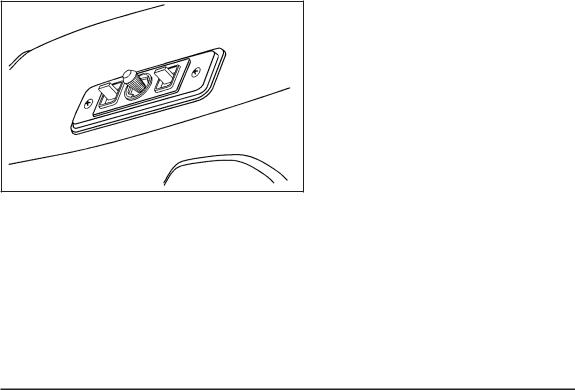
Power Seat
If the vehicle has front power seat(s), the controls are located at the front center of the seat cushion.
To raise or lower the seat, move the center knob up or down. To move the seat forward or rearward, move the center knob toward the right or left.
To raise or lower the front of the seat cushion, move the right lever up or down. To raise or lower the rear of
the seat cushion, move the left lever up or down.
2-3

Reclining Seatbacks
{ WARNING:
You can lose control of the vehicle if you try to adjust a manual driver’s seat while the vehicle is moving. The sudden movement could startle and confuse you, or make you push a pedal when you do not want to. Adjust the driver’s seat only when the vehicle is not moving.
{ WARNING:
If either seatback is not locked, it could move forward in a sudden stop or crash. That could cause injury to the person sitting there. Always push and pull on the seatbacks to be sure they are locked.
The seats have manual reclining seatbacks. The lever used to operate them is located on the inboard side of the seats.
To recline the seatback:
1.Lift the recline lever.
2.Move the seatback to the desired position, then release the lever to lock the seatback in place.
3.Push and pull on the seatback to make sure it is locked.
2-4

To return the seatback to an upright position:
1.Lift the lever fully without applying pressure to the seatback and the seatback will return to the upright position.
2.Push and pull on the seatback to make sure it is locked.
{ WARNING:
Sitting in a reclined position when the vehicle is in motion can be dangerous. Even when buckled up, the safety belts cannot do their job when reclined like this.
The shoulder belt cannot do its job because it will not be against your body. Instead, it will be in front of you. In a crash, you could go into it, receiving neck or other injuries.
The lap belt cannot do its job either. In a crash, the belt could go up over your abdomen. The belt forces would be there, not at your pelvic bones. This could cause serious internal injuries.
For proper protection when the vehicle is in motion, have the seatback upright. Then sit well back in the seat and wear the safety belt properly.
Do not have a seatback reclined if the vehicle is moving.
2-5

Rear Seats
Rear Seat Operation
Removing the Rear Seat
Disconnect the quick release latch plates for the lap-shoulder belts on the bench seat to be removed.
1. To do this, press the tip of a key into the release hole of
the safety belt buckle while pulling up on the safety belt.
2.Locate the pins.
On a three passenger seat there are two pins located on the inboard sides of the rear seats.
Three Passenger Seat Shown
The driver side pin has a gray cap with a black “L” marked on it.
2-6
